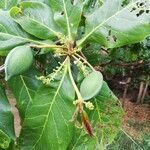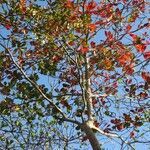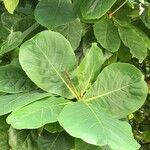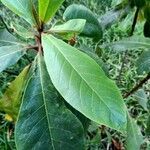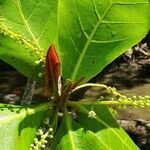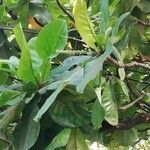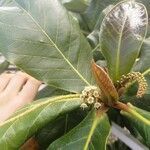Evergreen to briefly deciduous tree 2-35 m. Leaves chartaceous, obovate to broadly so or rarely elliptic-obovate, (8-)12-30(-38) x (5-)9-15(-22) cm, apex rounded to shortly acuminate, base tapering to usually cordate to subcordate (rarely rounded, subtruncate or cuneate), glabrous above, glabrous to appressed-pubescent below; domatia bowl-shaped, always present; venation eucamptodromous-brochidodromous, secondary veins 6-12 pairs, moderately spaced to distant, originating at moderately to widely acute angles, curved distally, prominent, intersecondary veins present; tertiary veins usually irregularly percurrent, often alternate and oblique; quaternary veins sometimes conspicuous; areolation randomly reticulate, imperfect or incomplete; petiole 0.5-2.5 cm long, pubescent, usually biglandular. Inflorescence (8-)13-30 cm long, simple, andromonoecious, with bisexual flowers few and near base; peduncle 3-5.5 cm long, glabrous to sparsely pubescent; rhachis (5-)10-27 cm long, pubescent. Flowers 5-merous, 3-5 x 4-7 mm (male) or 6-10 x 4-7 mm (bisexual); lower hypanthium 3-7 mm long in bisexual flowers, appressed-pubescent, usually densely so near base and sparsely so near apex, upper hypanthium cupuliform or campanulate, 1-2 mm long, sparsely pubescent; calyx lobes erect to patent or slightly recurved when at full anthesis, 1-1.5 mm long, nearly glabrous; stamens 2-4 mm long; disk villous; style 3-3.5 mm long, glabrous. Infructescence with few fruits near base of rhachis; fruit drupaceous but rather fibrous, glabrous, (3.5-)4-8 x 3-5.5 cm, ovoid to ellipsoid, slightly compressed, apex acute to acuminate or stoutly beaked, base rounded to broadly cuneate, obscure to conspicuous ridge or wing up to 6 mm wide along full length on each lateral edge.
Trees to 20 m tall; trunk to 2 m d.b.h. Bark brownish black, longitudinally peeling. Branches spreading, forming tiers. Branchlets densely brownish yellow tomentose near apex, densely covered with conspicuous leaf scars. Leaves alternate, crowded into pseudowhorls at apices of branchlets; petiole 0.5-2 cm, stout, tomentose; leaf blade obovate to oblanceolate, narrowed in proximal half, 12-30 × 8-15 cm, both surfaces glabrous or abaxially sparsely softly hairy when young, base narrow, cordate or truncate, apex obtuse or mucronate; lateral veins in 10-12 pairs. Inflorescences axillary, simple, long, slender spikes, 15-20 cm, numerous flowered; axis shortly white tomentose. Flowers fragrant. Calyx tube distally cupular, 7-8 mm, abaxially white tomentose, densely so on ovary, sparsely so on cupular part, adaxially glabrous; lobes 5. Stamens 10, exserted, 2-3 mm. Fruit not stipitate, red or blackish green when ripe, ellipsoid, slightly to strongly compressed, strongly 2-ridged to narrowly 2-winged (wings to 3 mm wide), 3-5.5 × 2-3.5 cm, glabrous; pericarp woody, rigid. Fl. Mar-Jun, Oct, fr. May, Jul-Sep.
Tree to 40 m high, rarely more than 15 m in Australia, deciduous. Branchlets thick, tomentose when young. Leaves crowded; lamina broadly obovate, 10–33 cm long, 7–17 cm wide, usually 1.4–2 times as long as wide, subcordate at base, obtuse or obtusely acuminate at apex, discolorous, velutinous, becoming almost glabrous when mature; domatia along midrib and lateral veins; petiole 4–20 mm long. Spike open, shorter than leaves. Flowers c. 6 mm diam., male flowers c. 5 mm long, bisexual flowers 10–13 mm long. Calyx glabrous; lobes triangular, c. 1.5 mm long and wide. Staminal filaments c. 3 mm long. Disc villous. Style glabrous. Mature fruit ellipsoidal, somewhat compressed, angled, 5–8 cm long, 2.5–5 cm wide, succulent, smooth, dark purple sometimes tinted red; immature fruit compressed, with distinct wings. See also Du Puy & Telford (1993: 244).
A large tree up to 25-40 m tall. It loses its leaves during the year. The trunk can be straight or twisted. There can be buttresses up to 3 m tall. The branches lie horizontally and come out in layers. The leaves are long, smooth and shiny with an abrupt point at the tip and a rounded base. Leaves tend to be near the ends of branches. Leaves can be 17-29 cm long and 10-15 cm wide. Young leaves have soft hairs. The leaves turn red and fall off twice a year. Flowers are greenish white and in a spike at the end of the branches. The lower flowers on a spike are female, then the others are male. The fruit is about 6 cm long by 3-4 cm wide, thick and flattened with a flange around the edge. The fruit are green and turn red when ripe. The pulp is edible.
